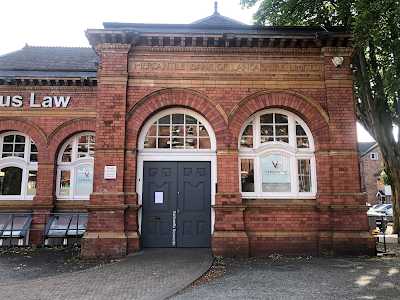Now I am back with that ghost bank.
It is one of those buildings that I have never given much thought to, but it caught Barbarella's eye recently on a walk, and she sent over a series of pictures, adding, "This used to be a physiotherapy centre, about twenty years ago. Lapwing Lane"
It is the former bank on Lapwing Lane and I must have passed it countless times, and on occasion stared at it from the window of the restaurant opposite.
I did once try to take some pictures but the light was wrong and I gave up which is a shame because I might have been inspired to dig down in to the history of The Mercantile Bank of Lancashire.
But Barbarella's pictures have caught it perfectly.
As yet I haven’t found out much other than it merged with the Lancashire and Yorkshire Bank in 1904 which merged with the Bank of Liverpool and Martin in 1927 which subsequently changed its name to Martins and in turn merged with Barclays in 1969.
But there will be someone out there who knows all about the bank and in time will be in touch.
In the meantime I know that our building dates from 1903, which means it had a brief existence as the Mercantile Bank.
Such are the exciting times of the banking world.
And since I posted this Richard has dug deeper and discovered that the Mercantile Bank Of Lancashire Ltd was "founded in 1890 with a head office at temporary premises in Guardian Buildings, Cross Street, Manchester, with capital of £1m, its early growth reflected the continuing industrial prosperity of Manchester.
The completion of the Manchester Ship Canal resulted in over 200 new accounts, and on 30 June 1891 the bank reported a net profit of £2,806.
Several branches were opened in the Manchester area, as well as others across Cheshire, Derbyshire, Staffordshire and Yorkshire.
In 1900 branches were acquired on the Isle of Man by amalgamation with the Manx Bank.
Soon after, however, the Mercantile Bank began to run into difficulty, partly due to the effect of the Boer War on investments.
The board of directors saw that as a relatively small bank, they could only survive by further amalgamation.
In the early part of 1904, several meetings were held with the Lancashire and Yorkshire Bank, and on 1 July the business of the Mercantile Bank was transferred to the Lancashire and Yorkshire Bank."*
And in turn the Lancashire and Yorkshire Bank merged with he Bank of Liverpool and Martin in 1927.
Pictures; former Mercantile Bank of Lancashire, 1903, from the collection of Barbarella Bonvento, 2020
*Barclays Bank PLC, https://www.archive.barclays.com/items/show/5305
It is one of those buildings that I have never given much thought to, but it caught Barbarella's eye recently on a walk, and she sent over a series of pictures, adding, "This used to be a physiotherapy centre, about twenty years ago. Lapwing Lane"
It is the former bank on Lapwing Lane and I must have passed it countless times, and on occasion stared at it from the window of the restaurant opposite.
I did once try to take some pictures but the light was wrong and I gave up which is a shame because I might have been inspired to dig down in to the history of The Mercantile Bank of Lancashire.
But Barbarella's pictures have caught it perfectly.
As yet I haven’t found out much other than it merged with the Lancashire and Yorkshire Bank in 1904 which merged with the Bank of Liverpool and Martin in 1927 which subsequently changed its name to Martins and in turn merged with Barclays in 1969.
But there will be someone out there who knows all about the bank and in time will be in touch.
In the meantime I know that our building dates from 1903, which means it had a brief existence as the Mercantile Bank.
Such are the exciting times of the banking world.
And since I posted this Richard has dug deeper and discovered that the Mercantile Bank Of Lancashire Ltd was "founded in 1890 with a head office at temporary premises in Guardian Buildings, Cross Street, Manchester, with capital of £1m, its early growth reflected the continuing industrial prosperity of Manchester.
The completion of the Manchester Ship Canal resulted in over 200 new accounts, and on 30 June 1891 the bank reported a net profit of £2,806.
Several branches were opened in the Manchester area, as well as others across Cheshire, Derbyshire, Staffordshire and Yorkshire.
In 1900 branches were acquired on the Isle of Man by amalgamation with the Manx Bank.
Soon after, however, the Mercantile Bank began to run into difficulty, partly due to the effect of the Boer War on investments.
The board of directors saw that as a relatively small bank, they could only survive by further amalgamation.
In the early part of 1904, several meetings were held with the Lancashire and Yorkshire Bank, and on 1 July the business of the Mercantile Bank was transferred to the Lancashire and Yorkshire Bank."*
And in turn the Lancashire and Yorkshire Bank merged with he Bank of Liverpool and Martin in 1927.
Pictures; former Mercantile Bank of Lancashire, 1903, from the collection of Barbarella Bonvento, 2020
*Barclays Bank PLC, https://www.archive.barclays.com/items/show/5305



No comments:
Post a Comment